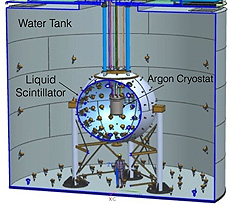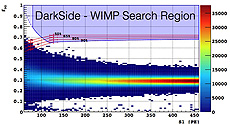Report from the DarkSide
 |
| This schematic of the DarkSide-50 apparatus shows the various layers that shield the detector. |
Nobody knows what dark matter, the invisible stuff that holds galaxies together, is made of, and many experiments, using many different technologies, are trying to discover it. The DarkSide-50 experiment, a U.S., Italy, France, Russia, Poland, China and Ukraine collaboration, is a search for one form suggested for dark matter, massive particles that interact weakly with ordinary matter (WIMPs).
Our experiment looks for WIMP interactions in a vat of 50 kilograms (110 pounds) of argon. We chose argon because its chemistry makes it a particularly powerful and sensitive detector material. At room temperature, argon is a gas (it is about 1 percent of the atmosphere); cooled to minus 270 degrees Fahrenheit, it becomes a transparent liquid with a density similar to water. When something happens in the liquid — a radioactive decay produces a neutron, a photon or an electron, or a WIMP hits an argon nucleus — the argon produces a flash of light and a number of free electrons. Light sensors called photomultipliers pick up the flash of light, converting it into an electric signal. The free electrons are pulled to the region of argon gas above the liquid, where they generate a second light signal, seen by the same photomultipliers.
The challenge in WIMP searches is identifying and removing all the "background" signals in the detector — signals from mundane sources — so that any surviving signals would be from dark matter. Backgrounds come from cosmic rays, which could produce neutrons that enter the detector and hit an argon nucleus, and from radioactivity of the material of the apparatus itself. For the latter, the combination of flashes tells us where the event occurred and allow us to identify and reject events from radioactivity on the surface of the detector.
The figure above shows other measures DarkSide uses to reject backgrounds. The cryostat that holds the argon is suspended inside a 13-foot-diameter steel sphere filled with scintillator oil designed to detect neutrons. The sphere sits inside a water tank, 33 feet high and 36 feet across, that detects muons and stops photons, and the whole apparatus sits in a hall as big as a cathedral at the Italian Gran Sasso National Laboratory under the Apennine mountains, east of Rome. The mountains stop most of the cosmic rays, and the water tank and scintillator oil sphere prevent anything (except dark matter particles and neutrinos) from getting into the argon without being spotted.
The experiment has just finished its first data-taking, a two-month run using atmospheric argon, which is slightly radioactive itself from cosmic-ray interactions. (The experiment will soon switch to low-radioactivity argon that comes from underground.) This modest data set has given us the third most sensitive limit on dark matter at high mass (around 100 times the proton mass). More significantly, the background from the argon radioactivity provides a powerful test of the experiment's capability to identify and reject signals from photons and electrons. The control of this background is very encouraging for longer exposures with the low-radioactivity argon and for the argon technology in general.
—Stephen Pordes
 |
| This scatter-plot shows two quantities for all the events recorded in this DarkSide-50 run. The x-axis is the energy of the event — the brightness of the first light flash. The y-axis is essentially the inverse of the duration of the flash (in time) — shorter pulses equate with larger values. The big splash of color is from the radioactivity of the argon itself. A single WIMP-like signal would give a blue square in the top shaded region. |
|